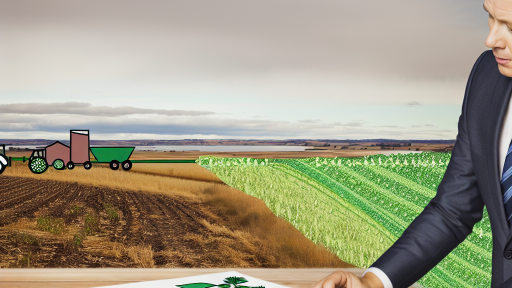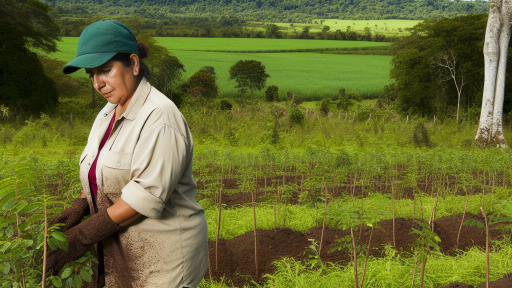Introduction to Value-Added Products in Agriculture
Value-added products offer farmers new revenue possibilities.
They transform raw agricultural goods into more valuable items.
This process benefits farmers, consumers, and the local economy.
Farmers can increase profit margins through diversification.
For example, producing jams from fruit can yield higher income than selling raw fruit.
Value-added products can also enhance market competitiveness.
Additionally, these products help in creating brand loyalty among consumers.
Many consumers prefer local, unique products over mass-produced alternatives.
Consequently, farmers can capitalize on this trend by offering distinctive items.
Transitioning to value-added products requires careful planning.
Farmers must assess their resources and production capabilities.
Understanding market demand is also crucial for success.
Producers should explore opportunities like processing, co-packing, and direct sales.
Networking with other producers can yield valuable insights and partnerships.
Investing in quality packaging and branding is equally important.
Transform Your Agribusiness
Unlock your farm's potential with expert advice tailored to your needs. Get actionable steps that drive real results.
Get StartedOverall, value-added strategies can significantly boost farm revenues.
As farmers adopt these practices, they contribute to sustainable agriculture.
Together, value-added products foster rural development and food security.
Identifying Local Market Needs and Opportunities
Understanding Community Demands
Every farm operates within a unique community.
Recognizing local preferences is crucial for success.
Farmers can conduct surveys to gather valuable insights.
This allows them to identify popular products and services.
Moreover, local farmers’ markets can be a goldmine of information.
Engaging with customers directly provides immediate feedback.
Analyzing Competitor Offerings
Monitoring competitors helps farmers understand market gaps.
Visit nearby stores and farmers’ markets regularly.
Take note of the products they offer and their pricing.
This research unveils opportunities for differentiation.
Innovative products can attract attention in a crowded market.
Leveraging Seasonal Trends
Seasonal changes significantly influence consumer behavior.
Farmers must adapt to these shifting demands.
For instance, produce volumes vary greatly throughout the year.
Understanding peak seasons for certain foods is essential.
Farmers can plan crop production accordingly.
They should also consider offering seasonal value-added products.
Collaborating with Local Businesses
Partnerships with local businesses can enhance visibility.
Cafes and restaurants often seek fresh local ingredients.
Establishing relationships with them can ensure steady sales.
Additionally, these partnerships can foster creative product ideas.
Showcase Your Farming Business
Publish your professional farming services profile on our blog for a one-time fee of $200 and reach a dedicated audience of farmers and agribusiness owners.
Publish Your ProfileJoint promotions can further engage the community.
Exploring Online Marketplaces
The digital marketplace is rapidly growing.
Farmers should consider selling products online to expand reach.
Creating an e-commerce platform is a effective way to do this.
Various online platforms exist to facilitate farm sales.
Farmers must market their stories to attract consumers.
Authenticity can build a loyal customer base online.
Types of Value-Added Products
Food Processing
Farmers can explore food processing to create value-added products.
This includes making jams, sauces, and baked goods.
Processed foods often have longer shelf lives and greater market demand.
For example, tomato growers can process excess harvests into salsa.
This not only reduces waste but increases potential profits.
Craft Beverages
Craft beverages are another option for value addition.
Farmers can produce homemade wines, beers, and ciders.
These products often attract a different customer base.
Additionally, they can enhance local tourism through tasting events.
Herb and Spice Blends
Creating unique herb and spice blends is also a viable route.
Farmers can leverage fresh ingredients to craft distinctive flavors.
This opens opportunities for selling at farmers’ markets or online.
Packed Snacks
Packed snacks, such as chips or granola bars, can be lucrative.
Farmers can utilize surplus produce in creative ways.
Healthy snack options appeal to health-conscious consumers.
Processing and Packaging Options
Processing Techniques
Effective processing techniques can enhance the quality of products.
Methods include canning, freezing, dehydrating, and fermenting.
Choosing the right technique is vital for preserving flavor and nutrients.
Farmers should consider their target market when selecting processing methods.
Packaging Solutions
Packaging plays a crucial role in product appeal and shelf life.
Farmers can opt for eco-friendly packaging to attract environmentally conscious customers.
Eye-catching designs help products stand out on store shelves.
Investing in quality packaging can enhance customer perception of value.
Labeling and Branding
Strong branding and effective labeling are essential for success.
Farmers must communicate product benefits clearly on labels.
Furthermore, engaging stories about farm origins can boost sales.
Investing in branding strategies sets products apart in the market.
Delve into the Subject: Designing Seasonal Farm Events To Attract Agritourism Visitors
Case Studies of Successful Value-Added Farming Ventures
Fresh Harvest Farm: Craft Beer from Local Grains
Fresh Harvest Farm embraced value-added products by producing craft beer.
The farm cultivates unique barley varieties specifically for brewing.
As a result, it attracts local breweries and craft beer enthusiasts.
This initiative increased the farm’s revenue significantly.
Moreover, community involvement strengthened local ties.
Showcase Your Farming Business
Publish your professional farming services profile on our blog for a one-time fee of $200 and reach a dedicated audience of farmers and agribusiness owners.
Publish Your ProfileSunny Fields Orchard: Artisan Jams and Jellies
This creative approach maximized profitability during peak seasons.
Customers appreciate the use of organic fruit without preservatives.
Consequently, sales expanded to local markets and online stores.
Their products earned awards, enhancing the orchard’s reputation.
Green Meadow Dairy: Specialty Cheese Production
Green Meadow Dairy ventured into specialty cheese production.
The farm sources quality milk from its own pasture-raised cows.
They offer a variety of cheeses, including unique flavors.
This diversification increased customer loyalty and market share.
Additionally, local cheese festivals raised brand awareness.
Breezy Hill Vineyard: Wine and Experiences
Breezy Hill Vineyard combined wine production with vineyard tours.
Visitors enjoy tastings alongside scenic views and farm tours.
This immersive experience enhances wine sales significantly.
The vineyard hosts events, creating additional revenue streams.
With time, their premium wines achieved critical acclaim.
Urban Roots Farm: Subscription Box Service
Urban Roots Farm developed a subscription box for fresh produce.
Customers appreciate the convenience of home delivery.
This model creates a steady income throughout the year.
Moreover, it fosters a community of loyal customers.
They include recipes, promoting the use of their products.
Find Out More: Diversification Through Specialty Crop Production
Financial Considerations
Budgeting for Value-Added Production
Budgeting is crucial for successful value-added production.
A clear budget helps farmers allocate resources efficiently.
It aids in identifying potential expenses and revenues.
Start by assessing current farm income streams.
Next, evaluate costs associated with value-added products.
Include raw materials, labor, and packaging in your estimates.
Consider marketing expenses to promote your new products.
Don’t forget about equipment costs if you need upgrades.
Subsequently, calculate projected sales to estimate potential revenue.
This will give you a clearer picture of profitability.
Understanding Break-Even Analysis
The break-even analysis is a valuable budgeting tool.
This analysis helps determine the minimum sales needed to cover costs.
Identify fixed and variable costs associated with production.
Fixed costs remain constant, while variable costs fluctuate.
Once identified, calculate your break-even point.
This is the level of sales required to avoid losses.
It’s essential for making informed financial decisions.
Monitoring Cash Flow
Monitoring cash flow is vital for financial health.
It ensures you have enough liquidity to meet obligations.
Showcase Your Farming Business
Publish your professional farming services profile on our blog for a one-time fee of $200 and reach a dedicated audience of farmers and agribusiness owners.
Publish Your ProfileTrack all income and expenses regularly.
Consider using accounting software for accuracy.
Prepare cash flow forecasts to plan for uncertainties.
This will help you anticipate potential shortfalls.
Assessing Profitability
Assessing profitability involves comparing income to expenses.
Regularly review your financial statements.
This practice highlights areas for improvement.
Evaluate which value-added products yield the highest margins.
Focus on those to enhance revenue streams.
Additionally, consider diversifying products to spread risk.
Seeking Financial Assistance
Financial assistance can help ease the initial investment.
Explore grants and loans aimed at supporting farmers.
Check with local agricultural agencies for resources.
Participating in workshops can also provide funding opportunities.
Furthermore, consider partnerships to share financial burdens.
Collaboration can lead to innovative product development.
You Might Also Like: Implementing Sustainable Practices In Agritourism Operations

Marketing Strategies for Value-Added Farm Products
Identifying Your Target Market
Understanding your audience is crucial for effective marketing.
Start by conducting surveys to gather insights about customers.
Analyze demographic data to identify potential buyers.
Segment the market based on preferences and buying behavior.
This segmentation helps tailor marketing messages to each group.
Developing Your Unique Selling Proposition
Craft a unique selling proposition (USP) to differentiate your products.
Your USP should emphasize quality, sustainability, or local sourcing.
Highlight what sets your products apart from competitors.
Create compelling stories that resonate with potential customers.
Utilizing Social Media Platforms
Leverage social media to connect with customers and showcase products.
Post engaging content such as recipes, farming techniques, and behind-the-scenes footage.
Encourage customer interaction through comments and shares.
Use targeted ads to reach specific demographics on various platforms.
Building Relationships with Local Businesses
Collaborate with local restaurants and grocery stores to expand distribution.
Consider hosting tasting events to introduce your products to potential buyers.
Establishing partnerships can enhance visibility and credibility.
Additionally, local businesses appreciate supporting their community.
Emphasizing Online Sales Channels
Set up an e-commerce store to reach a broader audience.
Utilize marketplaces like Etsy or Amazon to list your products.
Provide detailed product descriptions and high-quality images online.
Consider offering promotions to incentivize first-time buyers.
Engaging in Community Events
Participate in local farmers’ markets and community fairs.
These events create opportunities to showcase your brand directly.
Showcase Your Farming Business
Publish your professional farming services profile on our blog for a one-time fee of $200 and reach a dedicated audience of farmers and agribusiness owners.
Publish Your ProfileProvide samples and engage with your audience face-to-face.
Additionally, collect feedback to improve your offerings.
Implementing Effective Packaging Strategies
Invest in attractive yet practical packaging for your products.
Ensure that the packaging communicates your brand story clearly.
Eco-friendly options can appeal to environmentally conscious consumers.
Use eye-catching designs to attract attention on store shelves.
Monitoring and Adapting Marketing Strategies
Regularly review and assess the effectiveness of your marketing strategies.
Utilize analytics tools to measure engagement and sales performance.
Be open to adapting your approach based on market trends and feedback.
Consistent evaluation allows continuous improvement in your marketing efforts.
Discover More: Sustainable Supply Chain Strategies for Modern Farmers
Regulatory Considerations and Compliance for Value-Added Processing
Understanding Regulatory Frameworks
Value-added processing involves complying with various regulations.
Different jurisdictions may have different requirements.
Understanding these regulations is crucial for success.
Permits and Licenses
Before starting processing, obtain the necessary permits.
Licenses vary by product type and location.
Consult local agricultural departments for specific guidelines.
Food Safety Regulations
Adhering to food safety regulations is essential.
These regulations help in ensuring product safety for consumers.
Familiarize yourself with the FDA or USDA requirements.
Labeling Requirements
Product labeling must comply with federal and state regulations.
Accurate information about ingredients and nutrition is mandatory.
Understand specific labeling requirements based on your product type.
Implementing Quality Assurance Programs
A quality assurance program ensures compliance and product consistency.
Regular audits can help maintain quality standards.
Train staff on best practices for quality control.
Record Keeping and Documentation
Maintain comprehensive records of processing activities.
Documentation can be critical during inspections or audits.
Ensure records are easily accessible and up-to-date.
Staying Informed on Regulatory Changes
Regulations can change frequently, impacting your operations.
Stay informed by joining industry associations or forums.
Regularly review updates from relevant regulatory bodies.
Leveraging Technology and Innovation in Value-Added Production
Understanding Value-Added Products
Value-added products enhance the basic commodities produced on farms.
Farmers can transform raw materials into finished goods.
This approach increases profitability and marketability.
Examples include jams, cheeses, and organic packaged goods.
Moreover, value-added products cater to evolving consumer preferences.
Importance of Technology in Production
Technology plays a crucial role in modernizing agricultural practices.
Farmers now use precision agriculture tools for efficiency.
These tools help in monitoring crop health and optimizing yields.
Showcase Your Farming Business
Publish your professional farming services profile on our blog for a one-time fee of $200 and reach a dedicated audience of farmers and agribusiness owners.
Publish Your ProfileFor instance, drones assess land conditions in real-time.
Furthermore, software solutions facilitate better supply chain management.
Innovative Techniques for Processing
Innovative techniques boost the quality of value-added products.
For example, fermentation processes enhance flavor profiles.
Advanced packaging technologies improve shelf life and appeal.
Additionally, eco-friendly practices attract health-conscious consumers.
Investing in culinary training elevates product creativity.
Consumer Trends and Market Demand
Understanding consumer trends is vital for success.
Today’s consumers seek convenience and unique flavors.
Moreover, there is a growing demand for organic and local products.
Utilizing social media helps in reaching targeted audiences.
This platform allows producers to showcase their innovations.
Collaboration and Knowledge Sharing
Successful value-added production often involves collaboration.
Farmers can partner with local chefs and businesses.
This collaboration fosters an exchange of ideas and techniques.
Moreover, participating in workshops promotes technological advancements.
Networking with agricultural researchers can provide fresh insights.
Case Studies of Success
Many farms have successfully implemented value-added strategies.
For instance, Green Valley Farms launched an artisanal cheese line.
This initiative significantly increased their annual revenue.
Similarly, Riverbend Orchards created a popular range of fruit preserves.
These examples illustrate the potential of value-added products.




